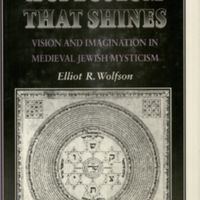Through a Speculum That Shines: Vision and Imagination in Medieval Jewish Mysticism
Dublin Core
Title
Through a Speculum That Shines: Vision and Imagination in Medieval Jewish Mysticism
Description
A comprehensive treatment of visionary experience in some of the main texts of Jewish mysticism, this book reveals the overwhelmingly visual nature of religious experience in Jewish spirituality from antiquity through the late Middle Ages. Using phenomenological and critical historical tools, Wolfson examines Jewish mystical texts from late antiquity, pre-kabbalistic sources from the tenth to the twelfth centuries, and twelfth- and thirteenth-century kabbalistic literature. His work demonstrates that the sense of sight assumes an epistemic priority in these writings, reflecting and building upon those scriptural passages that affirm the visual nature of revelatory experience. Moreover, the author reveals an androcentric eroticism in the scopic mentality of Jewish mystics, which placed the externalized and representable form, the phallus, at the center of the visual encounter.
In the visionary experience, as Wolfson describes it, imagination serves a primary function, transmuting sensory data and rational concepts into symbols of those things beyond sense and reason. In this view, the experience of a vision is inseparable from the process of interpretation. Fundamentally challenging the conventional distinction between experience and exegesis, revelation and interpretation, Wolfson argues that for the mystics themselves, the study of texts occasioned a visual experience of the divine located in the imagination of the mystical interpreter. Thus he shows how Jewish mystics preserved the invisible transcendence of God without doing away with the visual dimension of belief.
In the visionary experience, as Wolfson describes it, imagination serves a primary function, transmuting sensory data and rational concepts into symbols of those things beyond sense and reason. In this view, the experience of a vision is inseparable from the process of interpretation. Fundamentally challenging the conventional distinction between experience and exegesis, revelation and interpretation, Wolfson argues that for the mystics themselves, the study of texts occasioned a visual experience of the divine located in the imagination of the mystical interpreter. Thus he shows how Jewish mystics preserved the invisible transcendence of God without doing away with the visual dimension of belief.
Creator
Elliot R. Wolfson
Table Of Contents
Ch. 1. "Israel: The One Who Sees God" -- Visualization of God in Biblical, Apocalyptic, and Rabbinic Sources -- Ch. 2. Vision of God in Mystical Sources: A Typological Analysis -- Ch. 3. Visionary Ascent and Enthronement in the Hekhalot Literature -- Ch. 4. Theories of the Glory and Visionary Experience in Pre-Kabbalistic Sources -- Ch. 5. Haside Ashkenaz: Veridical and Docetic Interpretations of the Chariot Vision -- Ch. 6. Visionary Gnosis and the Role of the Imagination in Theosophic Kabbalah -- Ch. 7. The Hermeneutics of Visionary Experience: Revelation and Interpretation in the Zohar.
Text Item Type Metadata
Original Format
Book
Citation
Elliot R. Wolfson, “Through a Speculum That Shines: Vision and Imagination in Medieval Jewish Mysticism,” Humanities Hub, accessed December 8, 2025, https://humanitieshub.sdsu.edu/omeka/items/show/1414.

